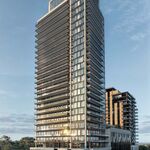nfitz
Superstar
Good grief ... you mean to tell me the TTC's 501 streetcar has a more advanced fare procedure than the Ottawa Transitway?
I do agree building rail infrastructure on the 401 would be prohibitively expensive, and I do not think it will attract many riders anyways. Taking away lanes from traffic on the 401 is never going to happen. This is why GO bus is perfect. People like to talk about serving "nodes." Well, STC, York Mills, Yorkdale, and York U can be served by GO running on the 401, and 407. The buses are obviously going to be better quality than transit buses. The long distance 407 express service is a good model to follow for long distance regional travel, in my opinion.
Keep in mind that the Transitway in Ottawa does not offer off-board payment. This means the driver must check and accept all payments from each passenger. If passengers paid their fare before boarding, the already impressive capacity numbers could be even higher.
+1
If OC Transpo took a page from VIVA and allowed all-door boarding with the occasional fare inspector patrolling on and off, the ridership would indeed be higher. And this is Ottawa, where half the city is well-to-do bureaucrats and the winters are brutal. Buses appeal to all rider classes and can tolerate the cold just as good as light-rail. Too bad about the boondoogle they're about to build there though.
I understand your incredulity, but BRT is a superior mode to LRT for longer disance trips, in all aspects except for the number of required drivers (which is almost a negligible point in this context). I was amazed when I first visited Bogota, Colombia and my jaw dropped when I read about the capacities - the most recent figure is *45,000 ppdpd.* The experience shaped my life and why I'm a self-professed transit advocate:
2007 figures (completed phase II) used in the BRT Planning guide - see Annex 1 system comparisons. If you have time, the whole guide is very interesting. Bogota is for now pretty much international best-practices in BRT.
http://www.itdp.org/index.php/micros...lanning_guide/
2006 figures (nearly complete phase II): page ix of http://www.trb.org/news/blurb_detail.asp?id=6340
2005 figures - see the ppt 1.2 "Introduction to BRT", see the 6th to last slide.
http://www.uncrd.or.jp/env/est/news-BRT-nov05.htm
The system is also earning the city an estimated 25 million USD dollars in Carbon credits for reducing carbon emissions. http://www.c40cities.org/bestpractic...bogota_bus.jsp And this has even garnered mention along with Curitiba in the IPCC third report on Climate Change Mitigation Ch. 5 page 332) http://www.ipcc.ch/pdf/assessment-re...g3-chapter5.pd
How it Works
1) they run *2* lanes in each direction, with inside lane is routes that stop at every station, and the outside lane is used for routes that skip most stations and only stop at some stations (the most popular & crowded)
2) Ridiculously high frequencies - the busiest stations have a bus arriving every 13 seconds during peak hours. Note that the stations are quite compact too - they are all fit in the median.
3) Fast boarding/offboarding - the average duration of a bus at a station from door open to door close is 24 seconds
4) Bogota is very dense - at 270 ppl per hectare, has city-wide density slightly higher than *central* Paris (or the fabled west end of Vancouver). That puts a lot people walking distance to lines. Imagine Finch West, Sheppard East, Jane or Don Mills with one of these. It's all in one's optics whether bus transit is inferior to rails when initial and O&M costs for the former can be remarkably more affordable.
The largest light rail vehicles are about 10-15% larger in capacity than the largest buses, with a much lower percentage seated. By the time you actually do get to the scale where LRT requires less drivers, you enter the realm of heavy rail, and you require much much greater densities in order to support it.
I think a system that offers services that are 10 - 15 mins frequency is useless here (it will lose out to people who will just drive every time). That's why the 190 isn't as heavily utilized as it should be, because of the prolonged waittimes.
Rubbish. The TTC's annual ridership is going up and a lot of that's due to improved bus service (note: the 70 second headways along Finch East). Over 80% of all TTC customers use the bus network. When both the subway and streetcars break down we always revert back to tried and tested buses as our salvation. We did so along St Clair W these past couple years using replacement buses and the headways dramatically improved.
No ... Transit systems throughout North America have been seeing decreased ridership in 2009. See Downturn in Public Transit Ridership Reflects Economic Times and First Quarter 2010 Public Transit Ridership Declines at Slower RateTransit systems all around the world I think have been experiencing increased ridership. The explanatory factor might not be improved bus service. It might be the crashed economy.
The largest light rail vehicles are about 10-15% larger in capacity than the largest buses, with a much lower percentage seated. By the time you actually do get to the scale where LRT requires less drivers, you enter the realm of heavy rail, and you require much much greater densities in order to support it. I think a system that offers services that are 10 - 15 mins frequency is useless here (it will lose out to people who will just drive every time). That's why the 190 isn't as heavily utilized as it should be, because of the prolonged waittimes.
You guys are a big bunch of babies!
Are you talking about the TTC's route 190? The 190 Rocket runs at a completely unbearable 330 second frequency and it overlaps a route running at an absolutely atrocious 240 second frequency. The route kilometres on the 190 have easily doubled or tripled since the route started running - service has been improved every year....and it still leaves people behind in the bus bay at Don Mills, every day.
I am actually incredulous that you're so full of it. Honestly. You are really full of it. I do not normally say that about people either.
Your second paragraph was total nonsense, and not really worthy of a reply. It's really amazing the stuff you post.
I haven’t needed to rely on the 190 route for a few years now so my mind thought back to when that route schedule was less frequent, particularly during the mid-day off-peak hours when I typically use it. At those combined headways between Don Mills and Midland that exist now though, it’s pretty feasible to insist that subway levels of demand are already occurring along this section of Sheppard East.




